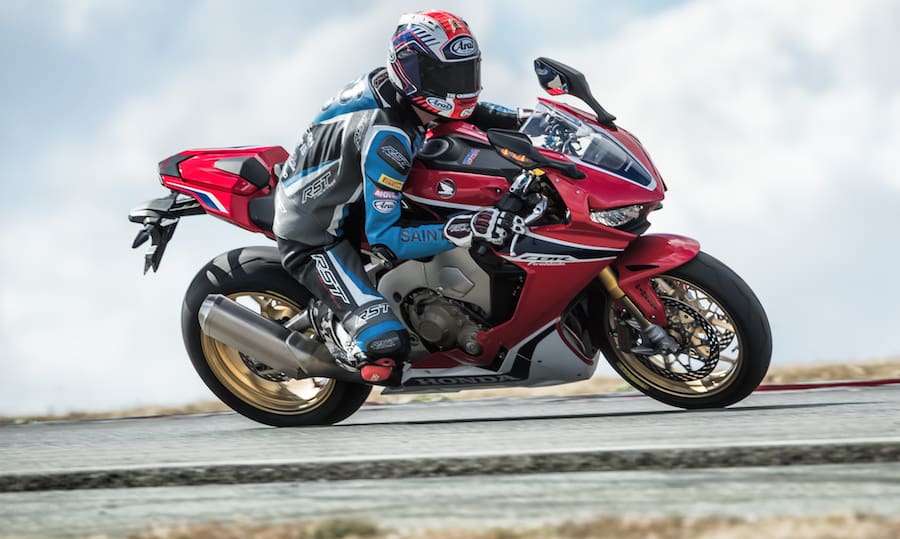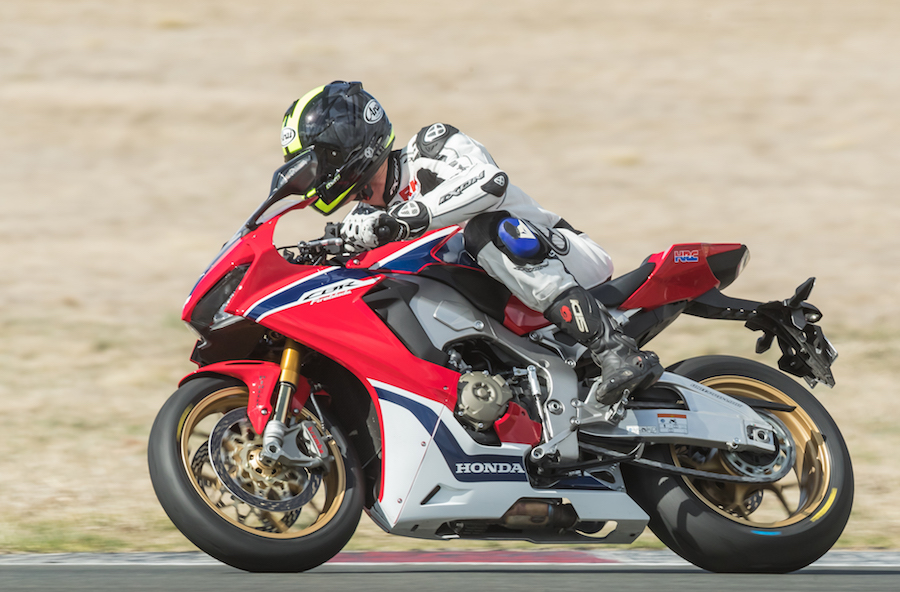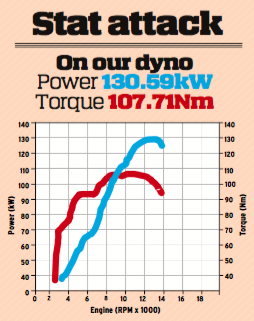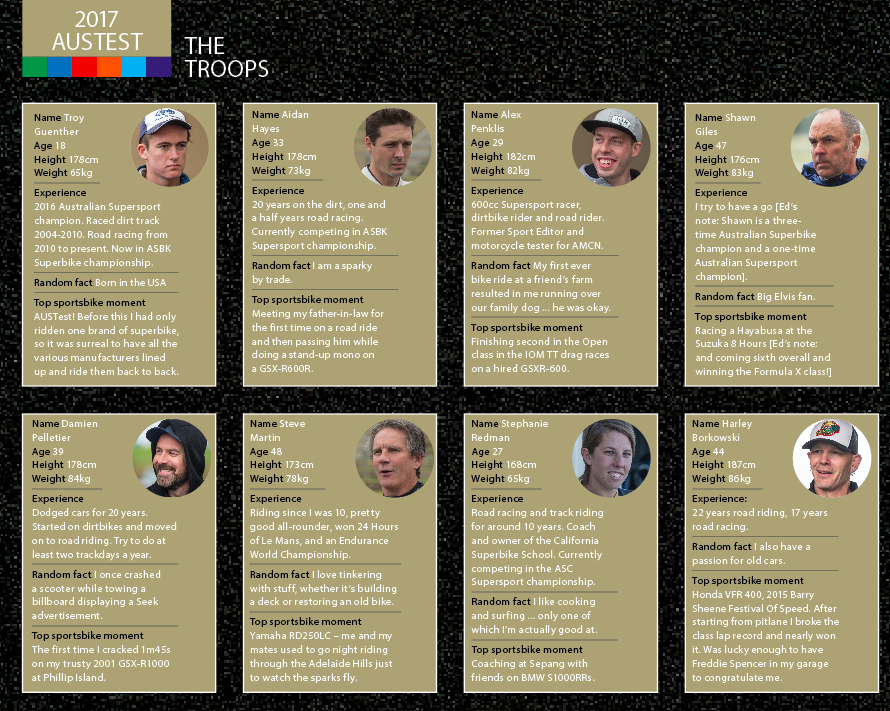There is no doubt Honda needed to release a new Fireblade this year. The last major revamp happened back in 2008, and since that time Blade owners have been crossing their fingers that something new was around the corner. When Honda’s RC213V-S production bike appeared there were faint hopes we would also see a cheaper version of the V4 – a configuration that could have grabbed some real attention – but alas we have to wait a bit longer yet.
Detailed refinement was the path chosen for the new Blade and when AMCN tested the standard model at Phillip Island earlier this year I thought it was the best Blade I’d ever ridden. That’s not true anymore because the SP has upped the ante with a bunch of refinements that might just find Blade lovers forking out the $28,499 (+ ORC) it’s going to cost to park one in their garage.

Uprated Brembo brakes, bi-directional quickshifter, a single seat and a lighter lithium battery are nice touches that help differentiate this bike from its standard sister, but as with the Yamaha and Ducati the big difference is in the bike’s semi-active Öhlins suspension. A TTX36 racing rear shock and a NIX30 43mm front fork make the already nimble blade sharper than ever before on the track, and yet at the touch of a button you can get a much softer setting for the road.
Honda took AUSTest seriously, letting reigning ASBK champion Troy Herfoss ride the bike at Wakefield Park a week before we arrived to tune the standard settings into a decent race spec. It was great arriving on the day and being able to change suspension, engine braking, traction and the power map all to Troy’s preferred settings with one touch.
On the track the Blade proved a hit for all the riders with many liking its aggressive race ergos and the World Rally Car growl emanating from the standard exhaust – it gave the pilots a major buzz. One of the big areas of improvement has been in weight reduction. The CBR has shed close to 10kg compared to last year’s bike, increasing its agility and braking prowess. The gearbox was strong and positive and the riders had nothing but praise for the bi-directional quickshifter. And the upbeat comments were reflected in the lap times, with the Blade second fastest around the circuit.
This is the first year Honda has fitted ride-by-wire to any production motorcycle (other than the RC213V-S) and the throttle connection was silky smooth, making it very easy to read the grip in slippery conditions and when on the edge of the tyre.
The consensus was that the CBR’s electronics package was pretty good for a first full-blown effort, but work needed to be done to bring it up to the level of the Euro contingent. Despite that, the CBR keys were fought over regularly, not only for the track aspect but for the road too.

Three Things
- The new CBR1000RR SP is the most slippery Blade to hit the market yet
- Up and down quickshifter comes standard on the SP – one of the little extras that might convince you to part with an extra $6000 over the base model
- Holey triple clamps! The hollowed top clamps not only look good, they help improve handling

Second Ops
Alex Penklis
The throttle response of the CBR would have to be one of the best I have ever felt on a motorcycle. The initial opening is jerk-free and the engine responds as if your right wrist is connected directly to its throttle bodies.
Shedding 10kg is noticeable on the track with a super-fast tip-in. I found the front on the twitchy side, especially under power as it skimmed across the bumpy Wakefield Park surface.
The electronic system is easy to understand though there was one quirk – the engine braking settings go in the opposite direction to the numbers on the switch.
The TFT dash was one of the least cluttered, allowing you to get the information you want quickly and without confusion.

Harley from RB Racing says…
The Honda tested as well on the dyno as it did on the road. It’s sharp and responsive, the ride-by-wire throttle feels connected to the rear wheel, and it really changes with different mode settings. The transmission and up-down quickshifter are smooth and positive, and the whole package has the typical high-quality feel we’re used to from Honda. The fuelling set-up is damn near perfect, and would only need an adjustment if an aftermarket exhaust system were to be fitted.


IN THIRD PLACE IS….
The Honda CBR bristles with excellence using a different design methodology to the Suzuki. It’s technically all new with virtually none of the part numbers matching up to its predecessor, the 2016 SP. But at the same time it’s uncannily similar in its dimensions to last year’s bike. The frame is the same, but a different thickness that helps with handling; the engine’s the same but heavily modified, making it faster than ever before. But the best part is that it still manages to retain the general feel from 2016, including all the traits CBR customers love and praise.
Although this ‘new but similar’ philosophy has come together well to make the best ever road-going CBR, is there enough change to whip up a frenzy? True, it’s lighter, faster and has a completely updated appearance, but sometimes more radical change is needed to make a mark. Even so we found the CBR to be an extremely exciting bike, with our diverse array of riders praising its performance and buzz factor.
Finishing so close to the winner in our shootout is a testament to the new Blade’s performance – it deserves to stand on the AUSTest podium.

2017 AMCN AUSTest
Once it was the kind of cutting-edge technology you’d find only on MotoGP and WSBK bikes; now electronic assist systems and dynamic suspension are the rule for all big-bore production superbikes, not the exception.
In our last AUSTest, back in 2015, we celebrated the rebirth of the superbike, when the world’s top manufacturers pulled themselves out of the GFC doldrums and got back to work creating proper one-litre speed machines. Bugger the cost, and bugger the practicality they said.
Two years later, the world’s fastest and most desirable machines have morphed once more. With big-bore nakedbikes becoming the machine of choice for the regular rider wanting usable power, handling and looks in a package they can live with day to day, production superbikes have become the Ferraris and Lamborghinis of the motorcycling world. Crammed full of power, performance and electronics few will ever fully test, and riding on a suspension package that can adjust itself on the fly, these machines are gorgeous examples of what is possible, yet are impractical for the road – and that’s why we love them.

In another first for AUSTest, every bike tested this year sits well over the $20,000 mark. If your five-figure budget begins with a 1, you are out of luck. All that technology comes at a cost, but as you are about to discover, a higher price mostly offers better value for money.
While the evolution of the superbike has continued unabated, one thing returning to the way of old is how we conduct AUSTest. For 2017, we were back in NSW and invited manufacturers to be hands on, requesting each deliver their bike accompanied by a factory-trained technician to help our test riders find the best possible set-up. Such is the high regard the manufacturers have for the AUSTest title, most sent multiple staff and the show looked more like a round of the ASBK than a shootout. That’s fitting, considering our AUSTest combatants often go head to head on the track.
In the end, there can be only one winner, and over the next 26 pages we will take you through the exhausting testing process. Then, when you think you have the winner sussed, we will reveal our champion. Enjoy the ride – we certainly did.

Day 1
Sydney Dragway
It’s a known fact that there’s no quicker way to get away from the lights than to use a machine producing in excess of 130kW and weighing just 200kg. Now, imagine a set of traffic lights where you don’t need to shut the throttle before changing to second gear and obliterating the speed limit. Such a place exists at Western Sydney. With a surface as sticky as shit on a blanket, and electronic timing with reaction times and speed traps, it’s a quarter mile of international-standard heaven that hosts some of the fastest drag bikes and cars in the world.
We lined our six AUSTest combatants up two at a time to test their launch and wheelie control, and of course, to see which could cover the quarter mile distance in the quickest time at the fastest speed. Before getting underway, those in the know said that a low 10-second pass would be impressive.
What eventuated left the experts gobsmacked.
Day 2
Wakefield Park Raceway, Goulburn
A regular stop on the ASBK circuit, Wakefield Park is tight and technical – an evil-handling bike will quickly be found out on the undulating 2.2km circuit. Throw in strong winds and unpredictable weather, and you need to be on the ball.
For a full day we rotated the six AUSTest bikes through the hands of the eight track-test riders. As conditions improved, and the technicians fine-tuned the bikes, the lap times began to drop. While there are no AUSTest points on offer for the fastest lap, there are definitely bragging rights, and everyone wanted them.
We won’t spoil the surprise, but we will say that the lap times set would have seen our stock-standard AUSTest entrants line up mid-grid at an ASBK round. Impressive stuff.
Day 3
Road ride, Goulburn to Sydney
The chosen route was 400km-plus of tight twisty and open country road special stages connected by freeway hops, all packed into a non-stop day. This provided the riders with a chance to sample each bike in the environment where it will be most used. An uncomfortable seating position or snatchy fuelling will always be revealed on a road ride. AUSTest titles have been won and lost in this section of the test.
Day 4
On the dyno
Are the claimed numbers bullshit? There is only one way to find out: with a dyno.
Our final destination for AUSTest 2017 was RB Racing at Caringbah where Harley Borkowski ran each of the bikes on the dynamometer to measure kW and Nm output. Harley was also one of our test riders this year, giving him the unique opportunity to see if the dyno numbers correlated to what the seat of his pants said.

THE METHOD
Who buys a superbike? A snapshot of the current superbike buying public will reveal possibly one of the widest demographics of any genre. Everyone from riders graduating from a restricted licence through to those who have worked long and hard enough to afford a few luxuries in life are buying superbikes. Highly skilled riders and racers buy them, as well as people who just want to look like Messrs Márquez, Rossi and Lorenzo at the local café – and drool over what a production superbike has to offer. AUSTest is as much about real-world performance and looks as it is about race pedigree and lap times, so we assembled a group of riders that represent the broad spectrum of superbike buyers. Daily riders, trackday junkies, endurance champs, national-title winners, professional test riders and young guns presently contesting the national Superbike and Supersport categories all made up the eight-rider test team charged with the task of determining who made the best two-wheeled missile for the best price.
Each rider was given two sessions on each bike on the drag strip, track and the road. Then they were handed an extensive voting form covering everything from how the bike performed and how it made them feel, through to value for money and which bike simply did it for you – regardless
of the cost.
While quarter-mile sprint and track lap times provided an indication of performance as well as plenty of entertainment and all-important bragging rights, it’s the results from the points-based voting sheets that determined the AUSTest 2017 champion.
Tyres
In years past we have experimented with a control tyre for AUSTest. While the idea works in theory, in reality most manufacturers have a commercial agreement with a tyre manufacturer, and the bike is developed using those tyres. If you are a superbike owner keen to cut some serious laps at a trackday, you will be faced with a few brand and rubber compound choices. To simulate a real-world situation, we left tyre choice to the manufacturers. As long as the tyre was DOT approved and available in Australia it was good to go.
Each manufacturer’s choice of tyre for AUSTest is provided on the test results. Most used just the one set of tyres for the drag strip and trackday, reverting to the OEM tyres for the road ride.
Timing
Each bike’s best quarter-mile time and top speed, as well as its fastest lap time on the track, do not form part of the voting criteria for AUSTest 2017, so this information is irrelevant – said no sane motorcycle lover ever. The minute the first bike shot down the quarter mile at Sydney Dragway or turned the first lap at Wakefield Park, everyone had their stopwatch out.
Sydney Dragway has its own timing system, but for Wakefield Park we needed something reliable, easy to install and easy to understand, that provided results instantly. The SpeedAngle lap timer ticked all these boxes. The team from SpeedAngle provided a unit for each bike, and even programmed the name of each model into the system so there could be no mix-ups. All six units performed faultlessly throughout the day, capturing every lap of every session.












